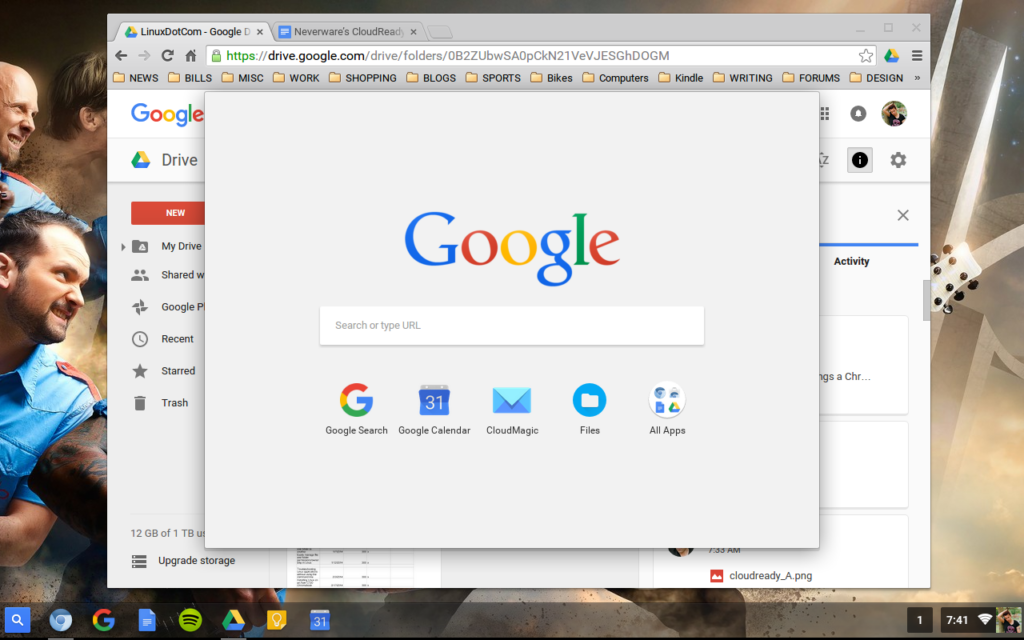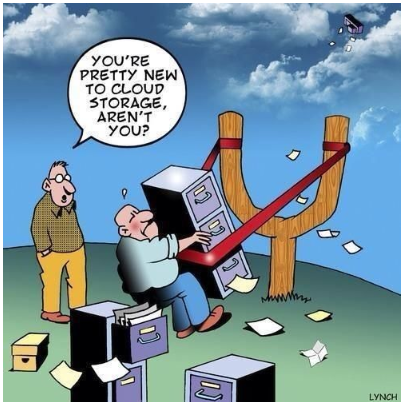Some trends in the development of IT technologies clearly hint to us that in the near future the computing power and capabilities of devices will grow, and these devices themselves will become simpler and cheaper. How is this possible? The answer is simple: clouds.
Cloud software
When in October 2006 Google announced the launch of Google Docs, and five years later Microsoft pulled up to them with its Office 365 subscription, some took the appearance of these new products with some skepticism. On the one hand, such a SAAS model allows you to get rid of the need to install software on your computer, thereby saving disk space. And the software itself can be used on any, even a rather weak machine, with any architecture and operating system – only a browser is required to work with Google Docs. On the other hand, the device must have a stable Internet connection, and at a decent speed, which was the main reason for doubts.
However, over the past decade, broadband internet has become available virtually all over the world. And the services themselves are actively developing: Google Sheets learned how to work with formulas a long time ago, and although they are still inferior in their capabilities to Excel, they will probably catch up soon – the developer has enough funds for this. Most likely, they will even get ahead. In addition, it is the “cloudiness” of Tables that allows them to be used as a database for an online store, a backend for web applications, and even for phishing purposes.
Another interesting project is a new Chromium OS variation called Cloud Ready. The operating system, which is basically a Linux kernel with a browser, and uses cloud services for the rest of the functionality. Fast loading, a completely modern graphical interface, the minimum required set of software (including the same Google Docs) and pretty nimble work on old hardware – what else do you need to view memes on the Internet and work with texts?

There is little doubt that very soon, most applications and toys will finally migrate to the cloud. Firstly, this will reduce the cost of hardware, since you can work with cloud software with confidence on almost any device, including tablets and smartphones, for which you cannot always find adequate office applications. Secondly, it is the ease of transferring user data. The moment is not far off when in all operating systems, after the first launch and login to the account, all user files, installed programs, drivers, mail, photos, saved games and correspondence in messengers will be automatically pulled up – the developers of Windows 10 are already trying to implement this using an account Microsoft records combined with OneDrive. It works, however, not yet very correctly, but the vector is generally clear.
Internet of things
But cloud technologies have the most perspectives, perhaps, in the world of the Internet of Things and microcomputers. Until recently, the arsenal of capabilities of controllers and single-board devices was largely limited to hardware configuration. The architecture and frequency of the processor, the amount of RAM – this primarily determines what software can be run on such a device, how much data it can process, and what it can therefore be adapted to. Right? Forget about it.
Above we talked about the SaaS model – “software as a service”, but there are two more categories of cloud solutions: platform as a service (PaaS), and infrastructure as a service (IaaS), when the client is provided with everything necessary to develop and launch their own solutions at different levels … It is the development of such services that will allow in the near future to completely transfer the backend of IoT applications to the clouds, leaving only the necessary minimum of software on the device itself – not demanding on hardware resources and capable of running on very weak cheap hardware. Something like this, for example, now many IP cameras work: the device itself only creates and transmits a picture over the network, and all the device settings, and the video itself, are available on a remote cloud server. This approach will make most IoT applications cross-platform and almost completely solve the problems associated with supporting different hardware configurations and different protocols, as well as combine various devices and sensors with universal mobile applications – that is, build complex heterogeneous networks without worrying about their support. individual components. In addition, cloud architectures are highly scalable. It is noteworthy that such solutions already exist now, just at this stage they have not yet gained popularity sufficient to compete with more successful commercial projects.
In addition to the already familiar “smart home” systems, distributed architectures with a cloud backend can be successfully applied in telemedicine and remote diagnostics, in intelligent industrial applications related to the operation of production equipment, in logistics, in transport management, in retail trade, in environmental monitoring infrastructure and measuring instruments and so on.
Most solutions from the IoT world, including smart home, require the analysis of large amounts of information, including historical data, and also involve identifying patterns for building scenarios of equipment behavior in the future. With the help of cloud computing, it is possible to significantly offload the equipment on the user’s side. Extracting actionable information from complex streaming data such as video is another example of an analysis that requires a lot of processing. And these volumes will only grow over time. There is a growing need to process data from various sources in different combinations; it is required to carry out their comparative and heuristic analysis. We must not forget that IoT systems are real-time systems in which the flow of information comes from many sources continuously, and appropriate resources are needed to manage these flows. It is necessary to quickly filter out inaccurate information coming from faulty sensors, since such data can ultimately lead to equipment damage or harm the user. In addition, all this bigdata needs to be stored somewhere. The clouds here are virtually uncontested solution, but it also has its own set of bottlenecks.
Problems and solutions
One of the significant obstacles to moving all resource-intensive data processing tasks to the clouds is the need to build server applications from the beginning with an eye on the cloud infrastructure. If a heterogeneous network with a large arsenal of completely different devices acts as a data source, the backend design can take on truly monstrous forms.
The obvious solution here is to move from a monolith to a microservice architecture. The use of microservices guarantees scalability, flexibility, as well as the ability to modify for new tasks and update server solutions without the need to completely stop the data processing. Actually, today there are few doubts that managed microservices are a promising technology that allows you to cope with the most complex tasks in the world of big data.

The second problem of moving data processing to the cloud can be, oddly enough, connectedness. Any problems at the level of public or backbone networks can lead to failures in the transfer of information between end devices and the cloud server. And, alas, it is very difficult to insure against such phenomena. One of the obvious solutions is to reserve communication channels and use third-party NS services. But this cannot serve as a 100% guarantee that the system will work without failures.
Now, in addition to cloud technologies, the concept of “fog computing” is being developed, which is considered to be more efficient when processing data in real time. This is very important indeed, as IDC predicts that by 2024 the number of endpoints in IoT networks will reach 41.6 billion worldwide, and the total traffic generated by them will amount to 79.4 zettabytes. However, the complexity of the “cloud Internet of things” is not limited to the computing power required to process such data arrays.
Security questions
Probably everyone knows what Shodan is. There are quite a lot of similar services designed to search for smart devices connected to the Internet. And hackers are actively using them to their advantage. Therefore, the intermediate link between the end devices of the Internet of Things and the cloud data center in the form of public networks can become the very Achilles heel that jeopardizes the security of the entire infrastructure. While encryption can be seen as a viable working solution here, it is unlikely to be a panacea.

Storing critical data in the cloud is also unlikely to generate enthusiasm among security fans – we read reports of hacked cloud services with enviable regularity. No matter how hard vendors try to protect virtual servers and storages from various types of attacks, sooner or later a critical vulnerability may be found in any software. And it is hardly possible to protect the user from himself.
And here there is another important point – the reason for many successful hacks and the appearance of search engines like the notorious Shodan are configuration errors. Some users of “smart” devices simply do not bother changing the default settings and the default password, which is why anyone can get access to them. Not to mention opening ports, disabling two-factor authentication, or not using VPN wherever needed. In other words, “cloud security engineer” is probably another profession that will only grow in relevance in the near term.
And then what?
Migration of services to the clouds is an inevitable and inevitable process, but at the same time, you should not consider it as an end point on the route of technological progress. Moving technology to the cloud and moving to microservice architectures does not automatically translate into increased productivity, overall efficiency, or profit. It’s a great tool for optimizing technology, but nothing more.
The focus on cloud technologies will largely change the approaches to the development of applied software and the software market in favor of the SaaS model with a gradual departure from traditional distribution schemes.
According to crn.com, the global cloud services market reached $ 120 billion in 2021 and continues to grow steadily. And analysts predict that the public cloud infrastructure market will expand another 28 percent next year. This segment of technologies can now be called one of the fastest growing, which means that in the near future we will be able to observe the transition to the clouds of more and more services – gaming, software, communication and others. This is our future.